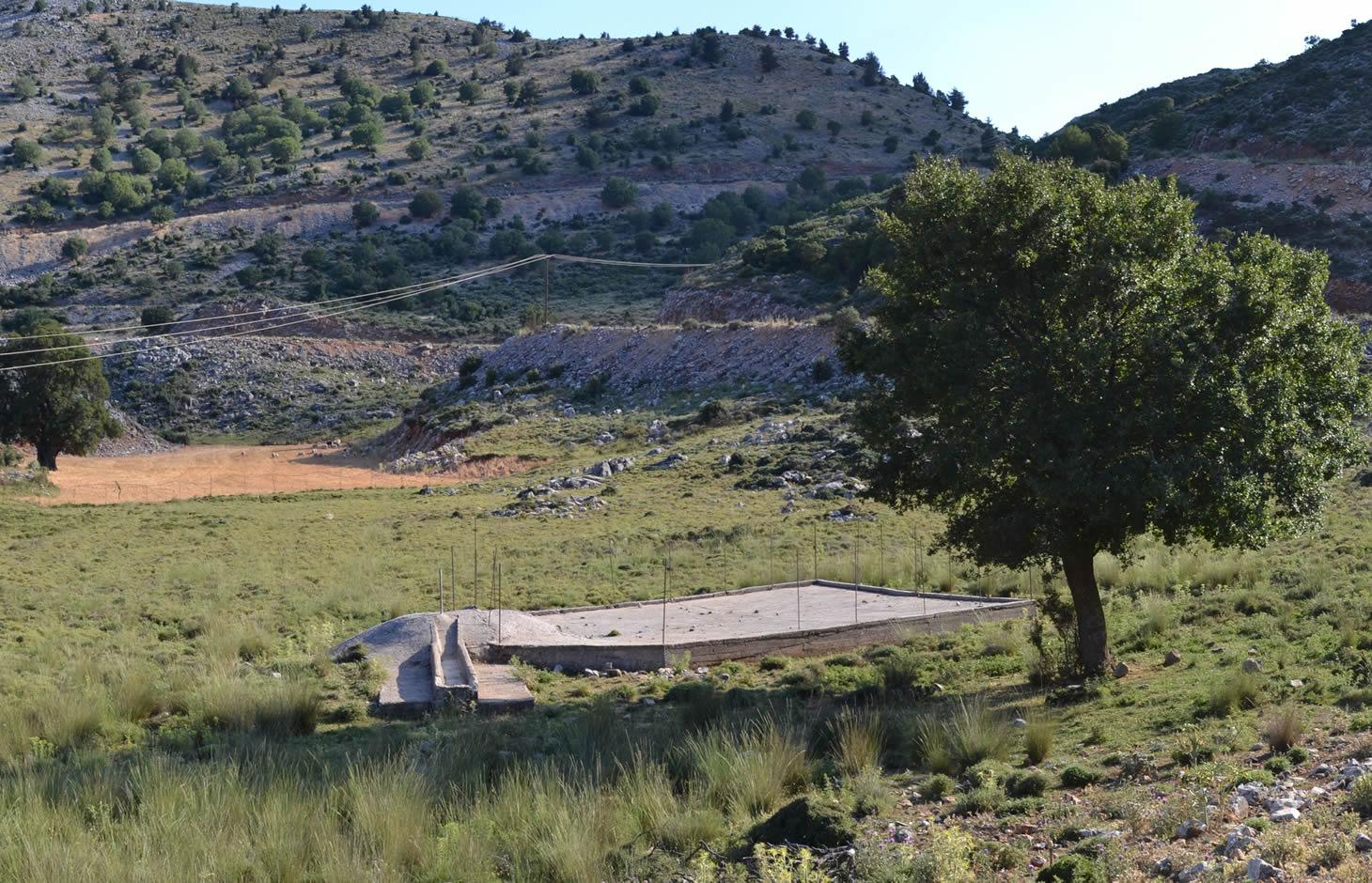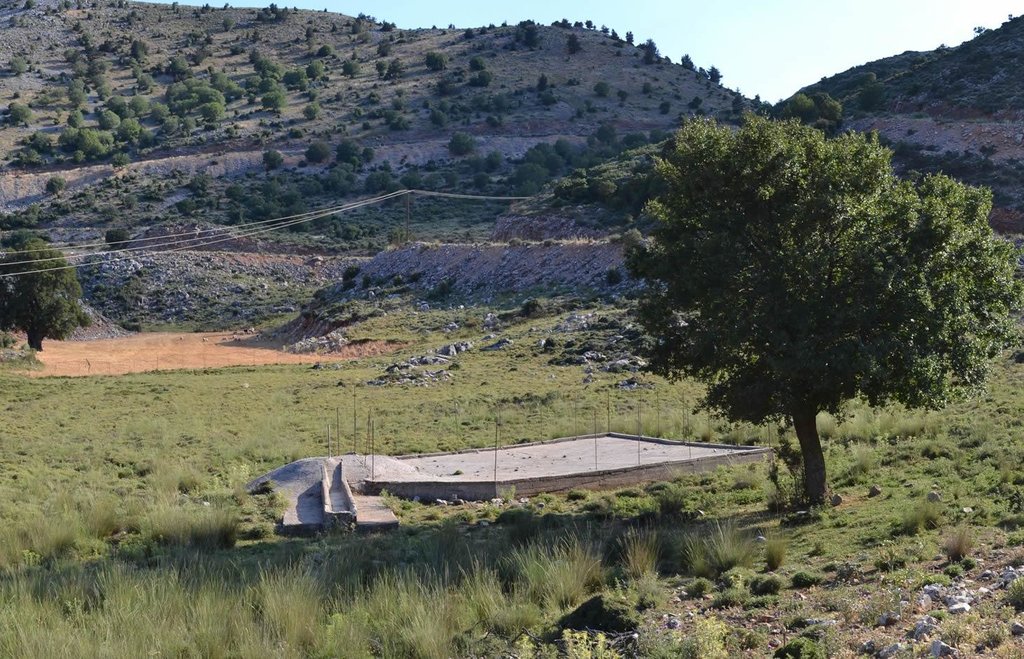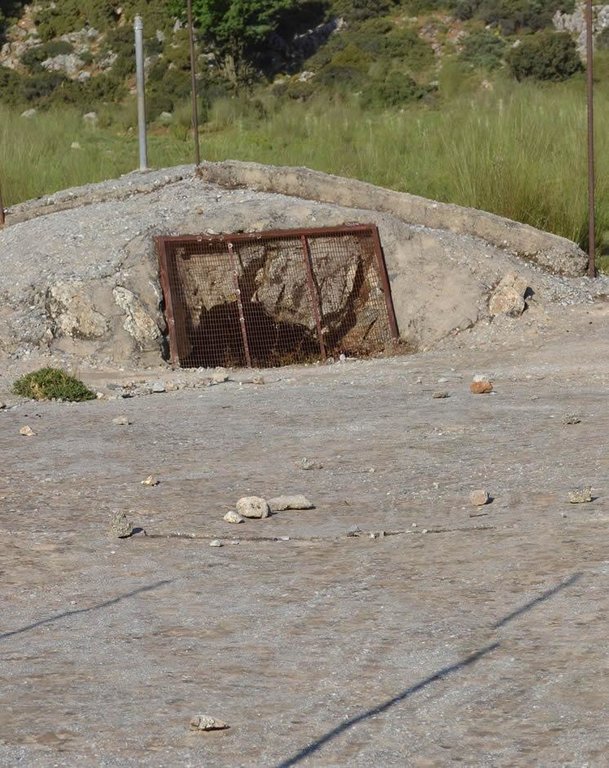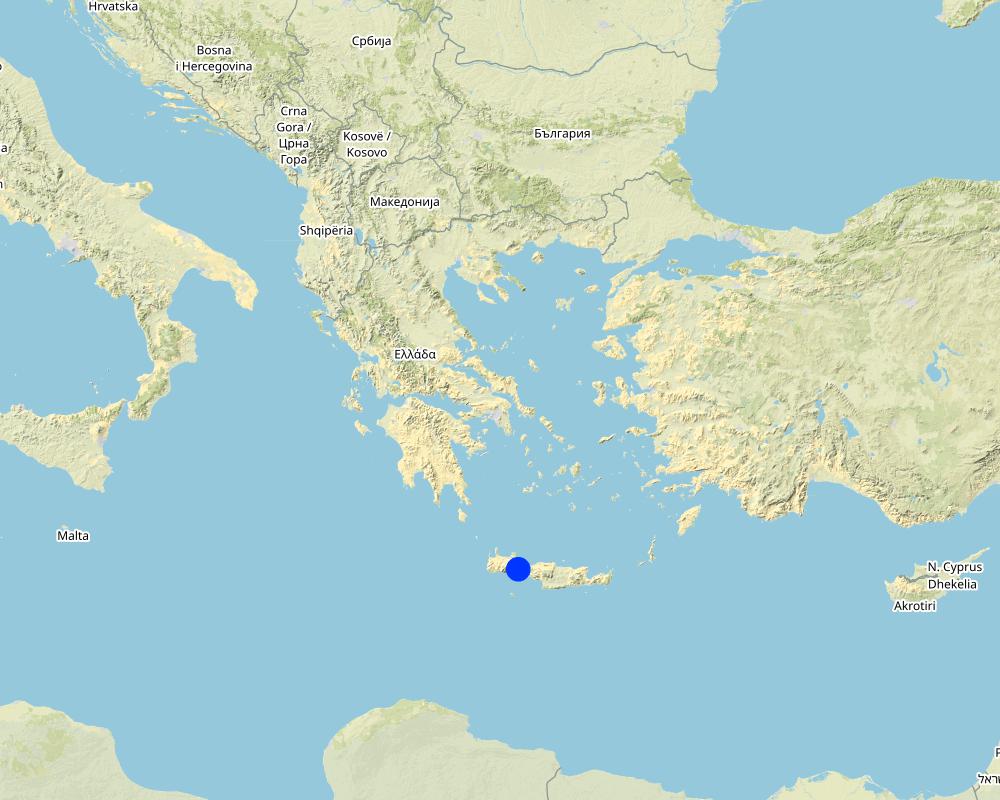Integrated water-harvesting and livestock water-point system [希腊]
- 创建:
- 更新:
- 编制者: Ioannis Daliakopoulos
- 编辑者: –
- 审查者: Alexandra Gavilano, Fabian Ottiger, Joana Eichenberger
Συνδυασμένο σύστημα συγκομιδής ομβρίων υδάτων και ποτίσματος αιγοπροβάτων
technologies_1206 - 希腊
查看章节
全部展开 全部收起1. 一般信息
1.2 参与该技术评估和文件编制的资源人员和机构的联系方式
SLM专业人员:
SLM专业人员:
Tsanis Ioannis
Technical University of Crete
希腊
有助于对技术进行记录/评估的项目名称(如相关)
Catastrophic shifts in drylands (EU-CASCADE)有助于对技术进行记录/评估的机构名称(如相关)
Technical University of Crete (Technical University of Crete) - 希腊1.3 关于使用通过WOCAT记录的数据的条件
编制者和关键资源人员接受有关使用通过WOCAT记录数据的条件。:
是
2. SLM技术的说明
2.1 技术简介
技术定义:
Integration of a cement pan and collection well system for water harvesting and a trough serving as a livestock water point.
2.2 技术的详细说明
说明:
An area of around 100 m<sup>2</sup> built out of cement or similar impermeable material forms an artificial watershed that drains into a well or tank, depending on landscape slope and system configuration. The well/tank, also made of cement to reduce losses due to infiltration, is covered in order to prevent water evaporation during the dry season. Its size depends on configuration and is ca. 40 m<sup>3</sup>. A detachable pumping system is used to draw water into a trough that is part of the permanent structure in a convenient location of the well or pan. The quality of water is maintained by keeping the collection area isolated from livestock using a removable chain-link fence placed on permanent metal poles. A grate is also installed at the opening of the well/tank to filter debris.
Purpose of the Technology: This system is installed in remote locations with poor access to fresh water. The water harvesting system collects water during the winter rains and snowfalls for use during the dry season. The trough of the system serves as a watering point for the user's livestock. This way the user can reduce the need of water transportation for his livestock, usually involving additional labor and transportation costs.
Besides the practical use of the water harvesting system, several functions are served with this installation. The existence of a source of soil moisture can cause a marked change in an otherwise very dry environment. Frequently these structures are jointly owned thus creating a sense of community among pastoralists.
Establishment / maintenance activities and inputs: Depending on initial slope, the water storage structure is designed. In relatively flat areas a well is dug and lined, whereas steeper slopes can be profited from by building part of the collection structure above ground. The later solution has a reduced cost and may also allow water extraction with natural flow. The technology can also be applied to extend the use of traditional wells by adding the rest of the structures. Exact sizing can be specified to allow storage of 10-20% over the average wet season precipitation in the area. After slope preparation, the collection structure, cement watershed and trough are constructed. The system is best established during autumn where temperature extremes that can make concrete curing difficult are less frequent. During the dry season, water can be extracted either by natural flow or a vacuum pump and channeled directly into the water point. Typically the cement structure and pumping system require little maintenance.
Natural / human environment: The harvesting system is best installed where the annual precipitation amount is sufficient but availability is hindered by seasonality, i.e. little natural storage exists and dry seasons yield little or no precipitation. The system is also most useful in remote locations with little or no access to water. Nevertheless, for the systems that require mechanical pumping, the location needs to be accessible by utility vehicle carrying relevant equipment and power supply.
2.3 技术照片
2.5 已应用该技术的、本评估所涵盖的国家/地区/地点
国家:
希腊
区域/州/省:
Chania
有关地点的进一步说明:
Askifou
注释:
Total area covered by the SLM Technology is 0.03 km2.
Map
×2.6 实施日期
如果不知道确切的年份,请说明大概的日期:
- 10-50年前
2.7 技术介绍
详细说明该技术是如何引入的:
- 通过项目/外部干预
注释(项目类型等):
The storage of the specific water harvesting system is part of a traditional well constructed around 1870 and the rest of the structures where added during the 90s though initiatives of the municipality.
3. SLM技术的分类
3.1 该技术的主要目的
- 改良生产
3.2 应用该技术的当前土地利用类型

牧场
粗放式放牧:
- 游牧
- 半游牧畜牧业
动物类型:
- 山羊
- 绵羊
注释:
Number of growing seasons per year: 1
Longest growing period in days: 298Longest growing period from month to month: 271-353
Livestock density: 50-100 LU /km2
Major land use problems (compiler’s opinion): precipitation seasonal variability causing water availability shortage during dry summers
Semi-nomadism / pastoralism: sheep/ goats
3.4 供水
该技术所应用土地的供水:
- 雨养
3.5 该技术所属的SLM组
- 集水
3.6 包含该技术的可持续土地管理措施

结构措施
- S5:大坝、集水斗、水池
- S11:其它
注释:
Main measures: structural measures
Specification of other structural measures: well and watering point
3.7 该技术强调的主要土地退化类型

水质恶化
- Ha:干旱化
- Hs:地表水良变化
注释:
Main type of degradation addressed: Ha: aridification
Secondary types of degradation addressed: Hs: change in quantity of surface water
Main causes of degradation: droughts
3.8 防止、减少或恢复土地退化
具体数量名该技术与土地退化有关的目标:
- 防止土地退化
- 减少土地退化
注释:
Main goals: mitigation / reduction of land degradation
Secondary goals: prevention of land degradation
4. 技术规范、实施活动、投入和成本
4.1 该技术的技术图纸
技术规范(与技术图纸相关):
The collection area, lined with cement, drains into the well through the collection point. A removable chain-link fence keeps the collection area isolated from livestock. A detachable pumping system can be connected to the pump installation point in order to supply the livestock water point with water from the well.
Date: 2/9/2014
Technical knowledge required for field staff / advisors: moderate
Technical knowledge required for land users: low
Main technical functions: water harvesting / increase water supply
Structural measure: well
Depth of ditches/pits/dams (m): 5
Width of ditches/pits/dams (m): 3
Length of ditches/pits/dams (m): 3
Structural measure: collection area
Depth of ditches/pits/dams (m): 0.1
Width of ditches/pits/dams (m): 10
Length of ditches/pits/dams (m): 10
Structural measure: watering point
Depth of ditches/pits/dams (m): 0.2
Width of ditches/pits/dams (m): 1
Length of ditches/pits/dams (m): 5
Structural measure: fencing
Height of bunds/banks/others (m): 1.5
Length of bunds/banks/others (m): 40
Specification of dams/ pans/ ponds: Capacity 40m3
Catchment area: 100m2
作者:
I. Daliakopoulos
4.2 有关投入和成本计算的一般信息
其它/国家货币(具体说明):
euro
如相关,注明美元与当地货币的汇率(例如1美元=79.9巴西雷亚尔):1美元=:
0.77
4.3 技术建立活动
| 活动 | 时间(季度) | |
|---|---|---|
| 1. | Field preparation | |
| 2. | Well digging | |
| 3. | Building of cement well cover | |
| 4. | Laying of concrete pan for water/snow collection | Installation |
| 5. | Installation of pumping tube | |
| 6. | Installation of cement watering point | |
| 7. | Fence installation | |
| 8. | Pump acquisition |
4.4 技术建立所需要的费用和投入
| 对投入进行具体说明 | 单位 | 数量 | 单位成本 | 每项投入的总成本 | 土地使用者承担的成本% | |
|---|---|---|---|---|---|---|
| 劳动力 | Labour | Dam | 1.0 | 2865.0 | 2865.0 | 100.0 |
| 设备 | Machine use | Dam | 1.0 | 580.0 | 580.0 | 100.0 |
| 施工材料 | Chain-link fence | Dam | 1.0 | 325.0 | 325.0 | 100.0 |
| 施工材料 | Concrete | Dam | 1.0 | 3270.0 | 3270.0 | 100.0 |
| 施工材料 | Cement pipes | Dam | 1.0 | 1940.0 | 1940.0 | 100.0 |
| 施工材料 | Pum | Dam | 1.0 | 390.0 | 390.0 | 100.0 |
| 技术建立所需总成本 | 9370.0 | |||||
| 技术建立总成本,美元 | 12168.83 | |||||
4.5 维护/经常性活动
| 活动 | 时间/频率 | |
|---|---|---|
| 1. | Pump maintenance | once a year |
4.6 维护/经常性活动所需要的费用和投入(每年)
| 对投入进行具体说明 | 单位 | 数量 | 单位成本 | 每项投入的总成本 | 土地使用者承担的成本% | |
|---|---|---|---|---|---|---|
| 劳动力 | Labour | Dam | 1.0 | 50.0 | 50.0 | |
| 技术维护所需总成本 | 50.0 | |||||
| 技术维护总成本,美元 | 64.94 | |||||
注释:
Costs were calculated for the construction of a well in 2014 for an easily accessible location. Nevertheless, the specific system is built around a traditional well thus its actual cost was lower.
4.7 影响成本的最重要因素
描述影响成本的最决定性因素:
Costs mainly depend on the well/tank contraction and the accessibility of the construction area (slope, proximity to road network, etc.)
5. 自然和人文环境
5.1 气候
年降雨量
- < 250毫米
- 251-500毫米
- 501-750毫米
- 751-1,000毫米
- 1,001-1,500毫米
- 1,501-2,000毫米
- 2,001-3,000毫米
- 3,001-4,000毫米
- > 4,000毫米
有关降雨的规范/注释:
Winter rains
农业气候带
- 半湿润
- 半干旱
Thermal climate class: subtropics
5.2 地形
平均坡度:
- 水平(0-2%)
- 缓降(3-5%)
- 平缓(6-10%)
- 滚坡(11-15%)
- 崎岖(16-30%)
- 陡峭(31-60%)
- 非常陡峭(>60%)
地形:
- 高原/平原
- 山脊
- 山坡
- 山地斜坡
- 麓坡
- 谷底
垂直分布带:
- 0-100 m a.s.l.
- 101-500 m a.s.l.
- 501-1,000 m a.s.l.
- 1,001-1,500 m a.s.l.
- 1,501-2,000 m a.s.l.
- 2,001-2,500 m a.s.l.
- 2,501-3,000 m a.s.l.
- 3,001-4,000 m a.s.l.
- > 4,000 m a.s.l.
关于地形的注释和进一步规范:
Landforms: On hill slopes configuration may differ, may not require pumping equipment
Slopes on average: Hilly (16-30%) configuration may change, may not require pump
5.3 土壤
平均土层深度:
- 非常浅(0-20厘米)
- 浅(21-50厘米)
- 中等深度(51-80厘米)
- 深(81-120厘米)
- 非常深(> 120厘米)
土壤质地(表土):
- 中粒(壤土、粉土)
表土有机质:
- 低(<1%)
如有可能,附上完整的土壤描述或具体说明可用的信息,例如土壤类型、土壤酸碱度、阳离子交换能力、氮、盐度等。:
Soil fertility is low
Soil drainage/infiltration is medium
Soil water storage capacity is very low
5.4 水资源可用性和质量
地下水位表:
> 50米
地表水的可用性:
匮乏/没有
水质(未处理):
良好饮用水
5.5 生物多样性
物种多样性:
- 中等
5.6 应用该技术的土地使用者的特征
生产系统的市场定位:
- 商业/市场
非农收入:
- 收入的10-50%
相对财富水平:
- 贫瘠
- 平均水平
个人或集体:
- 团体/社区
性别:
- 男人
说明土地使用者的其他有关特征:
Land users applying the Technology are mainly common / average land users
Population density: < 10 persons/km2
Annual population growth: 0.5% - 1%
5.7 应用该技术的土地使用者使用的平均土地面积
- < 0.5 公顷
- 0.5-1 公顷
- 1-2 公顷
- 2-5公顷
- 5-15公顷
- 15-50公顷
- 50-100公顷
- 100-500公顷
- 500-1,000公顷
- 1,000-10,000公顷
- > 10,000公顷
这被认为是小规模、中规模还是大规模的(参照当地实际情况)?:
- 中等规模的
注释:
Average area of land owned or leased by land users applying the Technology: 5-15 ha, 15-50 ha, 50-100 ha
5.8 土地所有权、土地使用权和水使用权
土地所有权:
- 个人,未命名
- 个人,有命名
5.9 进入服务和基础设施的通道
健康:
- 贫瘠
- 适度的
- 好
教育:
- 贫瘠
- 适度的
- 好
技术援助:
- 贫瘠
- 适度的
- 好
就业(例如非农):
- 贫瘠
- 适度的
- 好
市场:
- 贫瘠
- 适度的
- 好
能源:
- 贫瘠
- 适度的
- 好
道路和交通:
- 贫瘠
- 适度的
- 好
饮用水和卫生设施:
- 贫瘠
- 适度的
- 好
金融服务:
- 贫瘠
- 适度的
- 好
6. 影响和结论性说明
6.1 该技术的现场影响
社会经济效应
生产
生产故障风险
土地管理
水资源可用性和质量
家畜用水的可用性
家畜用水的质量
收入和成本
工作量
注释/具体说明:
Water does not have to be transported to distant locations
社会文化影响
食品安全/自给自足
冲突缓解
Improved livelihoods and human well-being
注释/具体说明:
Expansive grazing and the form of transhumance practiced Crete requires a huge commitment of human capital. The transportation of water or ensuring water availability between or close to grazing grounds is an essential need of the livestock, especially during dry years. This technology contributes to the reduction of workload and to rendering transhumance more manageable.
生态影响
水循环/径流
水量
水的回收/收集
土壤
土壤水分
6.3 技术对渐变气候以及与气候相关的极端情况/灾害的暴露和敏感性(土地使用者认为的极端情况/灾害)
渐变气候
渐变气候
| 季节 | 增加或减少 | 该技术是如何应对的? | |
|---|---|---|---|
| 年温度 | 增加 | 好 |
气候有关的极端情况(灾害)
气象灾害
| 该技术是如何应对的? | |
|---|---|
| 局地暴雨 | 好 |
| 局地风暴 | 好 |
气候灾害
| 该技术是如何应对的? | |
|---|---|
| 干旱 | 好 |
水文灾害
| 该技术是如何应对的? | |
|---|---|
| 比较和缓的(河道)洪水 | 好 |
其他气候相关的后果
其他气候相关的后果
| 该技术是如何应对的? | |
|---|---|
| 缩短生长期 | 好 |
6.4 成本效益分析
技术收益与技术建立成本相比如何(从土地使用者的角度看)?
短期回报:
消极
长期回报:
积极
技术收益与技术维护成本/经常性成本相比如何(从土地使用者的角度看)?
短期回报:
积极
长期回报:
积极
注释:
Initially, installation costs produce negative returns. Nevertheless the system requires little maintenance and the benefits emerge very soon, even after the first winter when the well has stored rain and snow water. As fuel expenses and human capital commitment for the transportation of water are significant, benefits predominate establishment costs within 2-3 years and maintenance / recurrent costs from the first year.
6.5 技术采用
如若可行,进行量化(住户数量和/或覆盖面积):
3
注释:
3 land user families have adopted the Technology with external material support
Comments on acceptance with external material support: The current trend is that traditional wells are converted to an integrated water harvesting system with external support from the municipality, thus foregoing the well construction costs.
There is a little trend towards spontaneous adoption of the Technology
6.7 该技术的优点/长处/机会
| 土地使用者眼中的长处/优势/机会 |
|---|
|
Decreases workload and costs during the dry season. How can they be sustained / enhanced? Workload and overall costs can be enhanced by increasing the density of water harvesting systems. |
| 编制者或其他关键资源人员认为的长处/优势/机会 |
|---|
|
Increases water availability for livestock during the dry season, promotes sustainable grazing. How can they be sustained / enhanced? Water availability can be sustained by promoting sustainable management of other grazing practices, e.g. maintaining a healthy LU/area ratio. |
| The system is decentralised and requires little maintenance. |
7. 参考和链接
7.1 信息的方法/来源
链接和模块
全部展开 全部收起链接
无链接
模块
无模块





